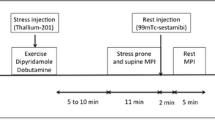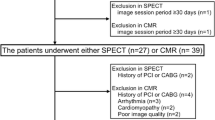Abstract
Myocardial contrast echocardiography (MCE) utilizes compressible microbubbles behaving similarly to red blood cells. Destruction of microbubbles and observation of the gradual refill into the myocardium are key to evaluating perfusion using real-time MCE. We aimed to assess the feasibility and diagnostic accuracy of qualitative MCE utilizing a 17-segment model for localization of myocardial perfusion abnormalities compared with simultaneous technetium-99 m sestamibi single-photon emission computed tomography (SPECT). From July 2005 through August 2007, 97 patients with known or suspected coronary artery disease underwent simultaneous SPECT and realtime MCE during adenosine stress. Qualitative MCE and tracer uptake were analyzed visually using a 17-segment model in a blinded manner. Diagnostic accuracy and 95% confidence interval (CI) were determined. Myocardial contrast echocardiography was completed in 91 patients (age, mean [SD], 69.3 [10.9] years; body mass index, 30.0 [6.3]; 59 males [65%]). Myocardial contrast echocardiography analysis was feasible in 88 (97%) patients (261 of 264 [99%] territories; 1299 of 1497 [87%] segments). At patient level, MCE sensitivity was 88% (95% CI, 79%–94%); specificity was 85% (77%–90%). For disease detection in individual coronary territories, sensitivity and specificity were 84% (71%–92%) and 79% (72%–84%) for the left anterior descending artery; 62% (38%–80%) and 88% (83%–91%) for the left circumflex artery; and 73% (57%–82%) and 94% (89%–97%) for the right coronary artery. For MCE combined with wall-motion analysis, concordance with SPECT improved from 80% to 86%. Myocardial contrast echocardiography interobserver concordance was 81% (κ [SE], 0.611 [0.78]). Myocardial contrast echocardiography accuracy was comparable in patients classified in accordance with presence of diabetes mellitus, myocardial infarction, hypertension, or percutaneous coronary intervention. Improved MCE specificity in detecting perfusion defects was seen in patients with no history of coronary bypass graft surgery (P = 0.005). Real-time MCE with a 17-segment model for analysis has good feasibility and accuracy in evaluation of myocardial perfusion during adenosine stress.
Similar content being viewed by others
References
Kaul S, Senior R, Dittrich H, Raval U, Khattar R, Lahiri A (1997) Detection of coronary artery disease with myocardial contrast echocardiography: comparison with 99 mTc-sestamibi singlephoton emission computed tomography. Circulation 5; 96(3): 785–792
Wei K, Crouse L, Weiss J, Villanueva F, Schiller NB, Naqvi TZ, Siegel R, Monaghan M, Goldman J, Aggarwal P, Feigenbaum H, DeMaria A (2003) Comparison of usefulness of dipyridamole stress myocardial contrast echocardiography to technetium-99 m sestamibi single-photon emission computed tomography for detection of coronary artery disease (PB127 Multicenter Phase 2 Trial results). Am J Cardiol 91(11):1293–1298
Korosoglou G, Dubart AE, DaSilva KG, Jr., Labadze N, Hardt S, Hansen A, Bekeredjian R, Zugck C, Zehelein J, Katus HA, Kuecherer H (2006) Real-time myocardial perfusion imaging for pharmacologic stress testing: added value to single photon emission computed tomography. Am Heart J 151(1):131–138
Xie F, Hankins J, Mahrous HA, Porter TR (2007) Detection of coronary artery disease with a continuous infusion of definity ultrasound contrast during adenosine stress real time perfusion echocardiography. Echocardiography 24(10):1044–1050
Kowatsch I, Tsutsui JM, Osorio AF, Uchida AH, Machiori GG, Lopes ML, Cesar LA, Ramires JA, Mathias W, Jr (2007) Head-tohead comparison of dobutamine and adenosine stress real-time myocardial perfusion echocardiography for the detection of coronary artery disease. J Am Soc Echocardiogr 20(9):1109–1117
Bossuyt PM, Reitsma JB, Bruns DE, Gatsonis CA, Glasziou PP, Irwig LM, Lijmer JG, Moher D, Rennie D, de Vet HC (2003) Towards complete and accurate reporting of studies of diagnostic accuracy: the STARD initiative. The Standards for Reporting of Diagnostic Accuracy Group. Croat Med J 44(5):635–638
Cerqueira MD, Weissman NJ, Dilsizian V, Jacobs AK, Kaul S, Laskey WK, Pennell DJ, Rumberger JA, Ryan T, Verani MS (2002) American Heart Association Writing Group on Myocardial Segmentation and Registration for Cardiac Imaging. Standardized myocardial segmentation and nomenclature for tomographic imaging of the heart: a statement for healthcare professionals from the Cardiac Imaging Committee of the Council on Clinical Cardiology of the American Heart Association. Circulation 105(4):539–542
Glas AS, Lijmer JG, Prins MH, Bonsel GJ, Bossuyt PM (2003) The diagnostic odds ratio: a single indicator of test performance. J Clin Epidemiol 56(11):1129–1135
Dijkmans PA, Knaapen P, Sieswerda GT, Aiazian E, Visser CA, Lammertsma AA, Visser FC, Kamp O (2006) Quantification of myocardial perfusion using intravenous myocardial contrast echocardiography in healthy volunteers: comparison with positron emission tomography. J Am Soc Echocardiogr 19(3):285–293
Hayat SA, Dwivedi G, Jacobsen A, Lim TK, Kinsey C, Senior R (2008) Effects of left bundle-branch block on cardiac structure, function, perfusion, and perfusion reserve: implications for myocardial contrast echocardiography versus radionuclide perfusion imaging for the detection of coronary artery disease. Circulation 117(14):1832–1841
Wilson RF, Wyche K, Christensen BV, Zimmer S, Laxson DD (1990) Effects of adenosine on human coronary arterial circulation. Circulation 82(5):1595–1606
Martin TW, Seaworth JF, Johns JP, Pupa LE, Condos WR (1992) Comparison of adenosine, dipyridamole, and dobutamine in stress echocardiography. Ann Intern Med 116(3):190–196
Iskandrian AE, Bateman TM, Belardinelli L, Blackburn B, Cerqueira MD, Hendel RC, Lieu H, Mahmarian JJ, Olmsted A, Underwood SR, Vitola J, Wang W (2007) ADVANCE MPI Investigators. Adenosine versus regadenoson comparative evaluation in myocardial perfusion imaging: results of the ADVANCE phase 3 multicenter international trial. J Nucl Cardiol 14(5): 645–658
Elhendy A, Tsutsui JM, O’Leary EL, Xie F, Porter TR (2006) Noninvasive diagnosis of coronary artery bypass graft disease by dobutamine stress real-time myocardial contrast perfusion imaging. J Am Soc Echocardiogr 19(12):1482–1487
Khoury AF, Rivera JM, Mahmarian JJ, Verani MS (1997) Adenosine thallium-201 tomography in evaluation of graft patency late after coronary artery bypass graft surgery. J Am Coll Cardiol 29(6):1290–1295
Moir S, Hanekom L, Fang ZY, Haluska B, Wong C, Burgess M, Marwick TH (2006) Relationship between myocardial perfusion and dysfunction in diabetic cardiomyopathy: a study of quantitative contrast echocardiography and strain rate imaging. Heart 92(10):1414–1419
Fujii N, Tsuchihashi K, Sasao H, Eguchi M, Miurakami H, Hase M, Higashiura K, Yuda S, Hashimoto A, Miura T, Ura N, Shimamoto K. (2008) Insulin resistance functionally limits endothelium-dependent coronary vasodilation in nondiabetic patients. Heart Vessels 23(1):9–15
Miszalski-Jamka T, Kuntz-Hehner S, Schmidt H, Miszalski-Jamka K, Hammerstingl C, Tiemann K, Ghanem A, Troatz C, Pasowicz M, Luderitz B, Omran H (2008) Impact of previous myocardial infarction on the incremental value of myocardial contrast to two-dimensional supine bicycle stress echocardiography in evaluation of coronary artery disease. Int J Cardiol 136(1):47–55
Greaves K, Dixon SR, Fejka M, O’Neill WW, Redwood SR, Marber MS, Senior R (2003) Myocardial contrast echocardiography is superior to other known modalities for assessing myocardial reperfusion after acute myocardial infarction. Heart 89(2): 139–144
Aggeli C, Christoforatou E, Giannopoulos G, Roussakis G, Kokkinakis C, Barbetseas J, Vlachopoulos C, Stefanadis C (2007) The diagnostic value of adenosine stress-contrast echocardiography for diagnosis of coronary artery disease in hypertensive patients: comparison to Tl-201 single-photon emission computed tomography. Am J Hypertens 20(5):533–538
Hamilos MI, Patrianakos AP (2005) AI-700 (Acusphere). Curr Opin Invest Drugs 6(9):956–961
Masugata H, Lafitte S, Peters B, Strachan GM, DeMaria AN (2001) Comparison of real-time and intermittent triggered myocardial contrast echocardiography for quantification of coronary stenosis severity and transmural perfusion gradient. Circulation 104(13):1550–1556
Korosoglou G, da Silva KG Jr, Labadze N, Dubart AE, Hansen A, Rosenberg M, Zehelein J, Kuecherer H (2004) Real-time myocardial contrast echocardiography for pharmacologic stress testing: is quantitative estimation of myocardial blood flow reserve necessary?. J Am Soc Echocardiogr 17(1):1–9
Vogel R, Indermühle A, Meier P, Seiler C (2009) Quantitative stress echocardiography in coronary artery disease using contrastbased myocardial blood flow measurements: prospective comparison with coronary angiography. Heart 95(5):377–384
Nemes A, Forster T, Geleijnse ML, Soliman OI, Ten Cate FJ, Csanády M (2008) Prognostic value of coronary flow reserve and aortic distensibility indices in patients with suspected coronary artery disease. Heart Vessels 23(3):167–173
Author information
Authors and Affiliations
Corresponding author
Rights and permissions
About this article
Cite this article
Abdelmoneim, S.S., Bernier, M., Dhoble, A. et al. Diagnostic accuracy of contrast echocardiography during adenosine stress for detection of abnormal myocardial perfusion: a prospective comparison with technetium-99 m sestamibi single-photon emission computed tomography. Heart Vessels 25, 121–130 (2010). https://doi.org/10.1007/s00380-009-1174-x
Received:
Accepted:
Published:
Issue Date:
DOI: https://doi.org/10.1007/s00380-009-1174-x




